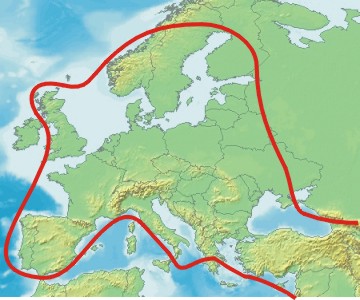- Roe Deer
Taxobox
name = Roe Deer
status = LC
status_system = iucn3.1

image_width = 299px
image_caption = Male and female Roe Deer
regnum =Animal ia
phylum =Chordata
classis =Mammal ia
ordo =Artiodactyla
familia =Cervidae
subfamilia = Odocoileinae
genus = "Capreolus"
genus_authority = Gray, 1821
species = "C. capreolus"
binomial = "Capreolus capreolus"
binomial_authority = (Linnaeus, 1758)
range_
range_map_caption=Range of "Capreolus capreolus"The European Roe Deer ("Capreolus capreolus") is adeer species ofEurope ,Asia Minor , and Caspian coastal regions. There is a separate species known as theSiberian Roe Deer ("Capreolus pygargus") that is found from theUral Mountains to as far east asChina andSiberia . The two species meet at theCaucasus Mountains , with the European species occupying the southern flank of the mountain ranges and adjacent Asia Minor and the Siberian species occupying the northern flank of the mountain ranges. Within Europe, the European Roe Deer occurs in most areas, with the exception of northernmostScandinavia (north ofNarvik ) and some of theisland s, notablyIceland ,Ireland , and theMediterranean Sea islands; in the Mediterranean region it is largely confined to mountainous regions, and is absent or rare at low levels.Etymology
English "roe" is from
Old English "raha", fromProto-Germanic "*raikhon", cognate toOld Norse "ra", German "Reh". The word is attested in the 5th centuryCaistor-by-Norwich astragalus inscription as "raïhan". Ultimately perhaps from aPIE root "*rei-" "streaked, spotted."Physical appearance
The Roe Deer is a relatively small deer, with a body length of 95-135 cm (3.1 - 4.4 ft), a shoulder height of 65-75 cm (2.1 - 2.5 ft), and a weight of 15-30 kg (33-66 lb). It has rather short, erect
antler s and a reddish body with a grey face. Its hide is golden red in summer, darkening to brown or even black in winter, with lighter undersides and a white rump patch; the tail is very short (2-3 cm, or 0.8 - 1.2 in), and barely visible. Only the males have antlers, which are lost during winter, but which re-grow in time for the mating season. The first and second set of antlers are unbranched and short (5-12 cm, or 2 - 4.7 in), while older bucks in good conditions develop antlers up to 20-25 cm (8-10 in) long with two or three, rarely even four, points. When the male's antlers begin to regrow, they are covered in a thin layer of velvet-like fur which disappears later on after the hair's blood supply is lost. Males may speed up the process by rubbing their antlers on trees, so that their antlers are hard and stiff for the duels during the mating season. Roe Deer are the only type of deer that can regrow their antlers during winter.Habitat and diet
The Roe Deer is primarily
crepuscular , or primarily active during the twilight, very quick and graceful, living in woods although it may venture to grasslands and sparse forests. It feeds mainly on grass, leaves, berries and young shoots. It particularly likes very young, tender grass with a high moisture content ie. grass that has received rain the day before. Roe deer will not generally venture in to a field that either has livestock in it (ie. sheep, cattle), or has recently had it in; this is because the livestock will make the grass very unclean. Apioneer species commonly associated with biotic communities at an early stage of succession, during theNeolithic period inEurope the Roe Deer was abundant, taking advantage of areas of forest or woodland cleared by Neolithic farmers (Boyle, 2006). However, sightings of Roe deer have become more common in back gardens in outer suburbs. One of the latest sightings of this kind was in a back garden in Brentwood, Essex.Behaviour and life cycle
The Roe Deer attains a maximum life span (in the wild) of ten years. When alarmed, it will bark a sound much like a dog and flash out its white rump patch. Rump patches differ between the sexes, with the white rump patches heart-shaped on females and kidney-shaped on males. Males may also bark, make a low grunting noise or make a high pitched wolf-like whine when attracting mates during the breeding season, often luring multiple does into their territory. The Roe Deer spends most of its life alone, preferring to live solitary except when mating during the breeding season.
Reproduction
The polygamous Roe Deer males clash over territory in early summer and mate in early fall. During courtship, when the males chase the females, they often flatten the underbrush leaving behind areas of the forest in the shape of a figure eight called 'roe rings'. Males may also use their antlers to shovel around fallen foliage and dirt as a way of attracting a mate. Roebucks enter rutting inappetence during the July and August breeding season. Females are monoestrous and after
delayed implantation usually give birth the following June, after a ten-month gestation period, typically to two spotted fawns of opposite sexes. The fawns remain hidden in long grass from predators until they are ready to join the rest of the herd; they are suckled by their mother several times a day for around three months. Roe deer adults will often abandon their young if they sense or smell that an animal or human has been near it. Young female roe deer can begin to reproduce when they are around 16 months old.ee also
*
Siberian Roe Deer References
* Prior, Richard 1995. "The Roe Deer : Conservation of a Native Species" (Swan-Hill Press) is regarded as the definitive work on roe deer in Great Britain.
*
*"", DK Adult Publishing, (2001), pg. 241.
* Boyle, K.V. 2006. Neolithic wild game animals in Western Europe: The question of hunting, pp 10 - 23. In "Animals in the Neolithic of Britain and Europe", Serjeantson, D, and Field, D (eds). Oxbow Books: Oxford.
*Lyneborg, L. (1971). "Mammals". ISBN 0-7137-0548-5.
*Reader's Digest, "The Wildlife Year", p. 228, ISBN 0-276-42012-8.External links
* [http://www.roedeer.com/ Roe Deer Research Group] .
Wikimedia Foundation. 2010.
